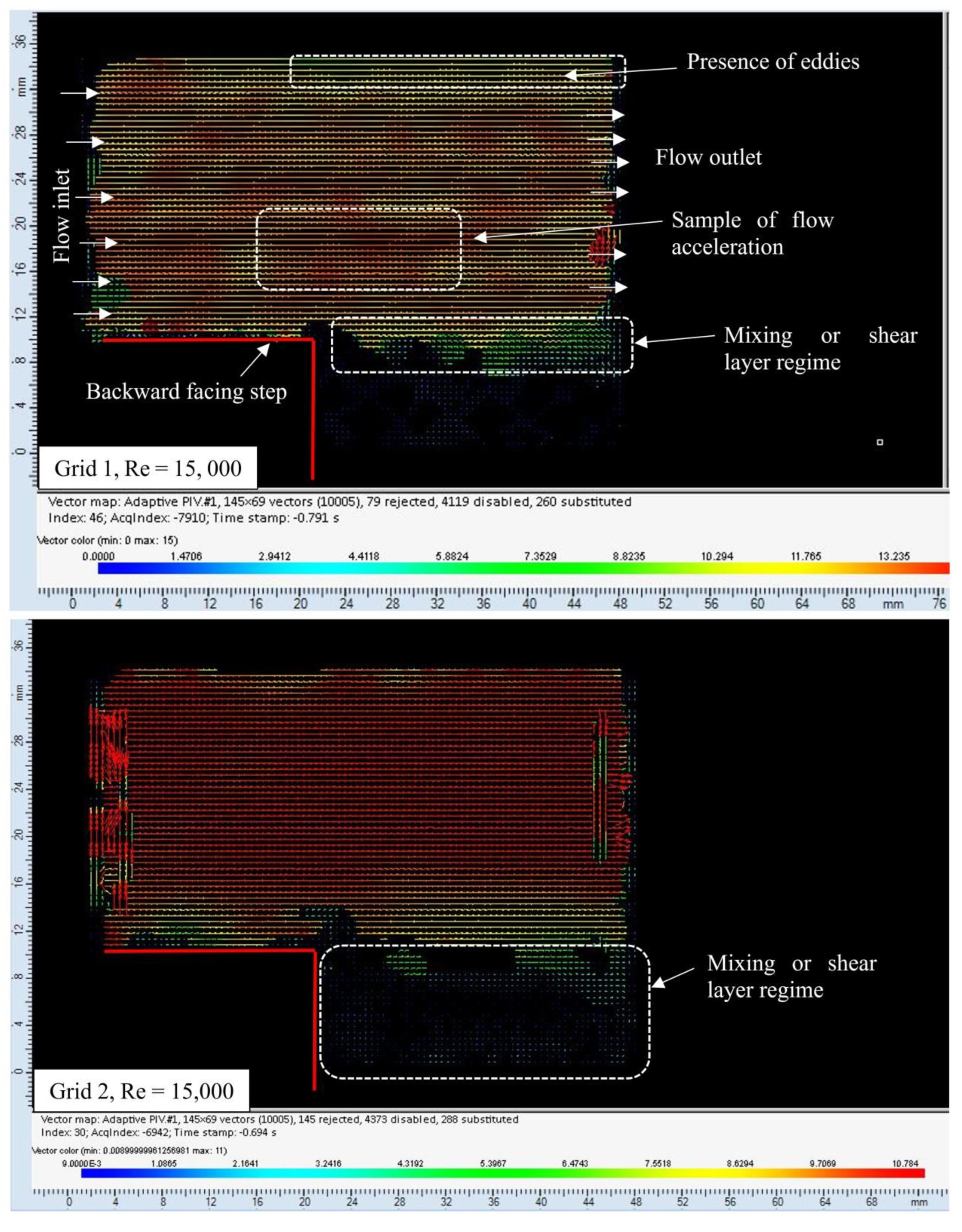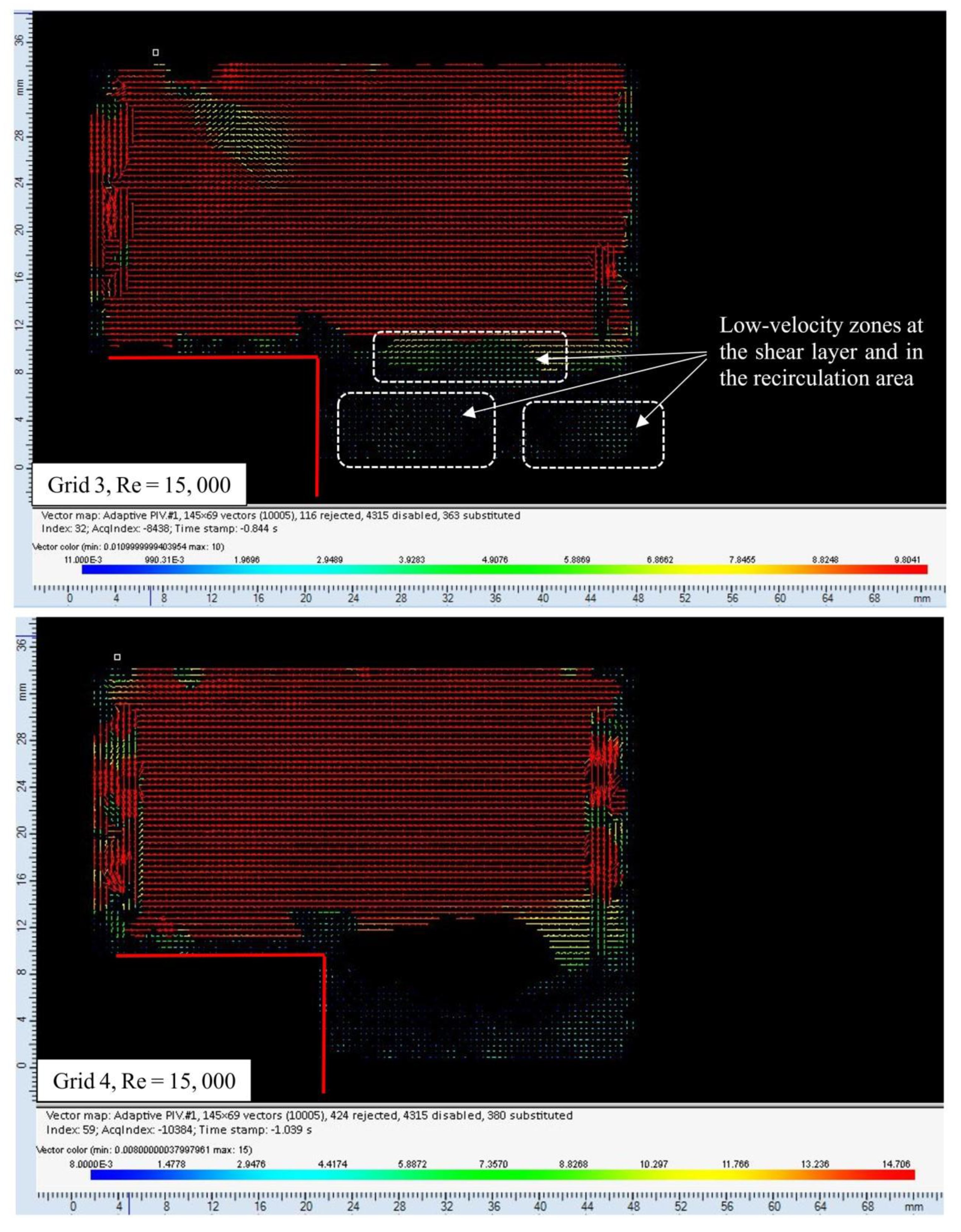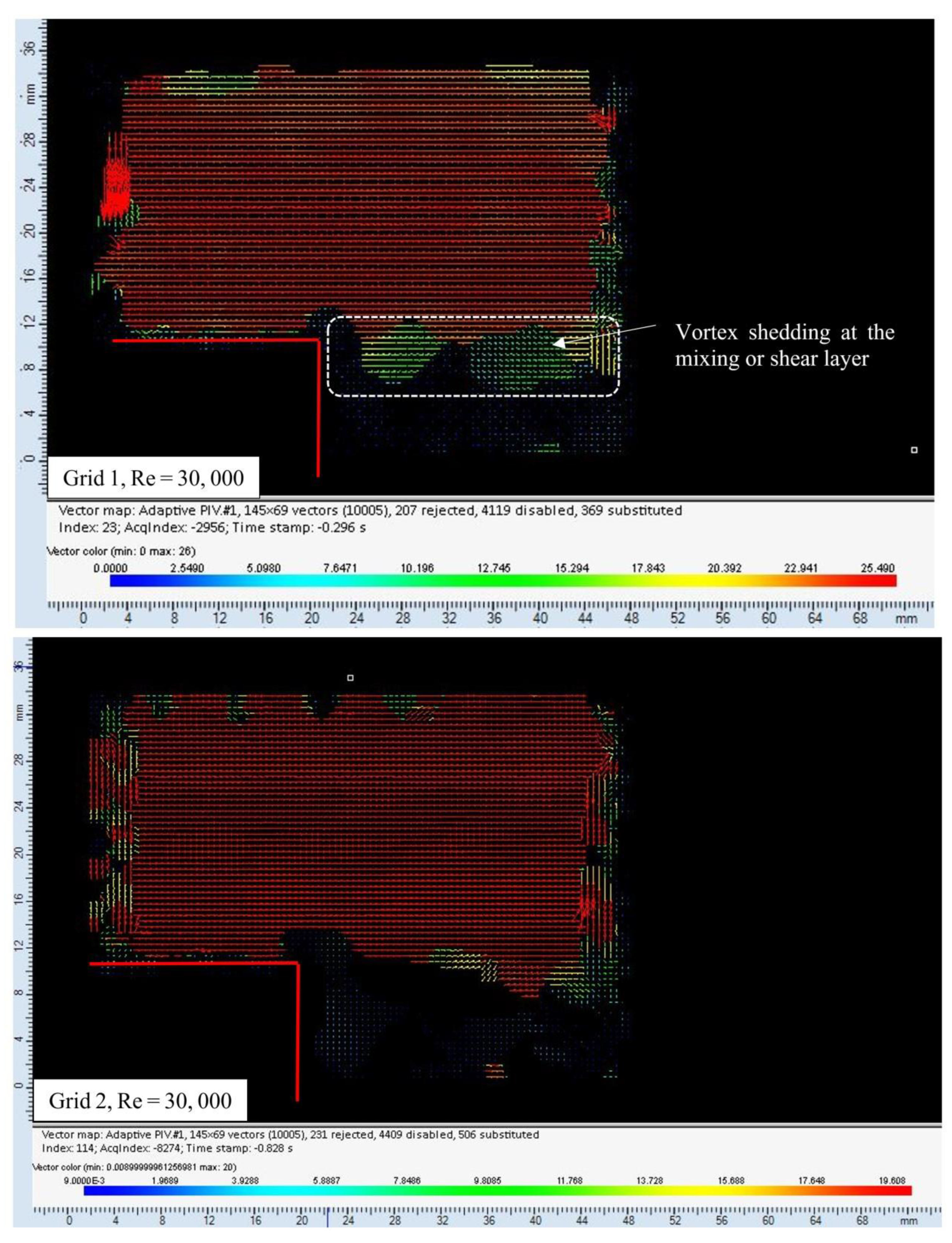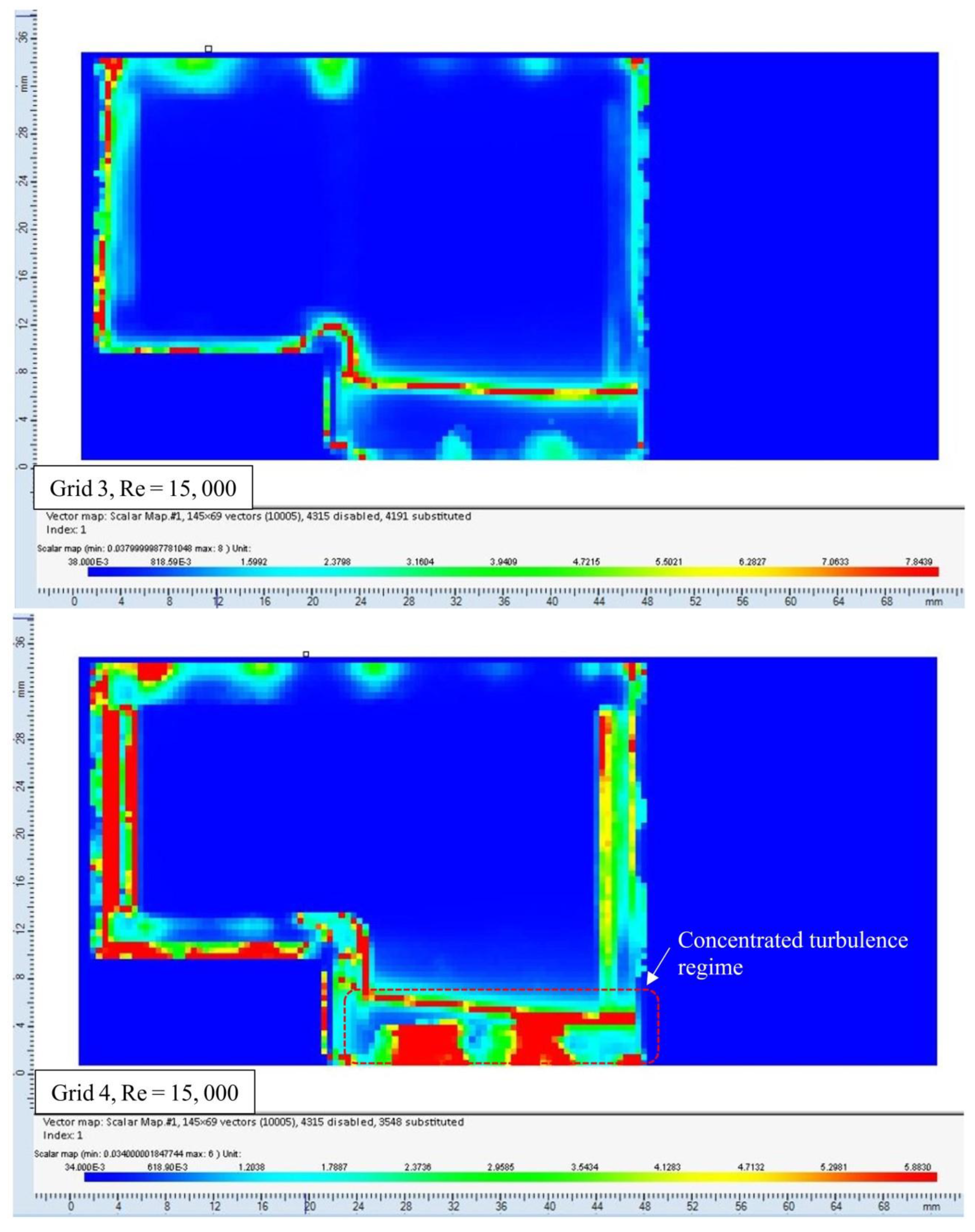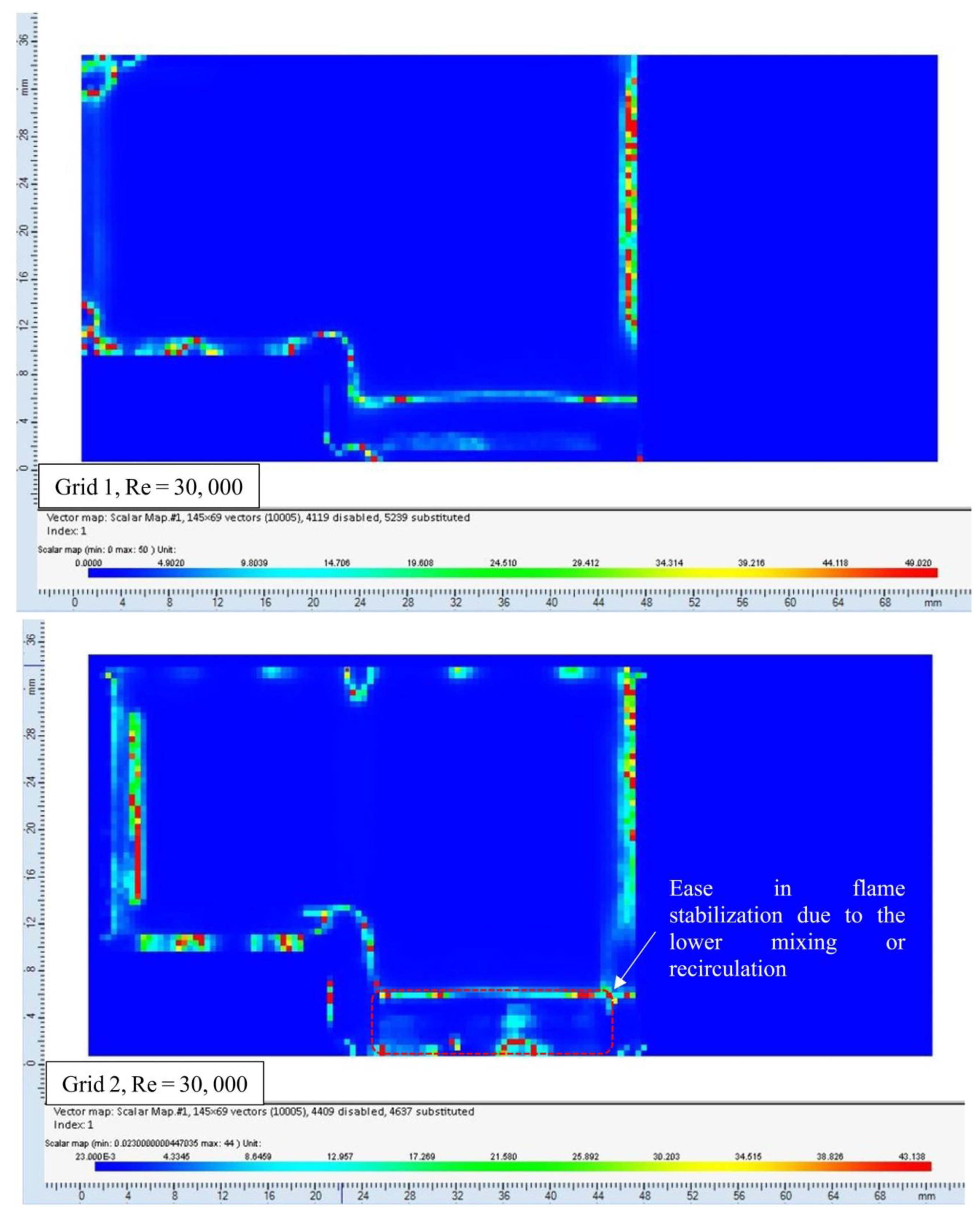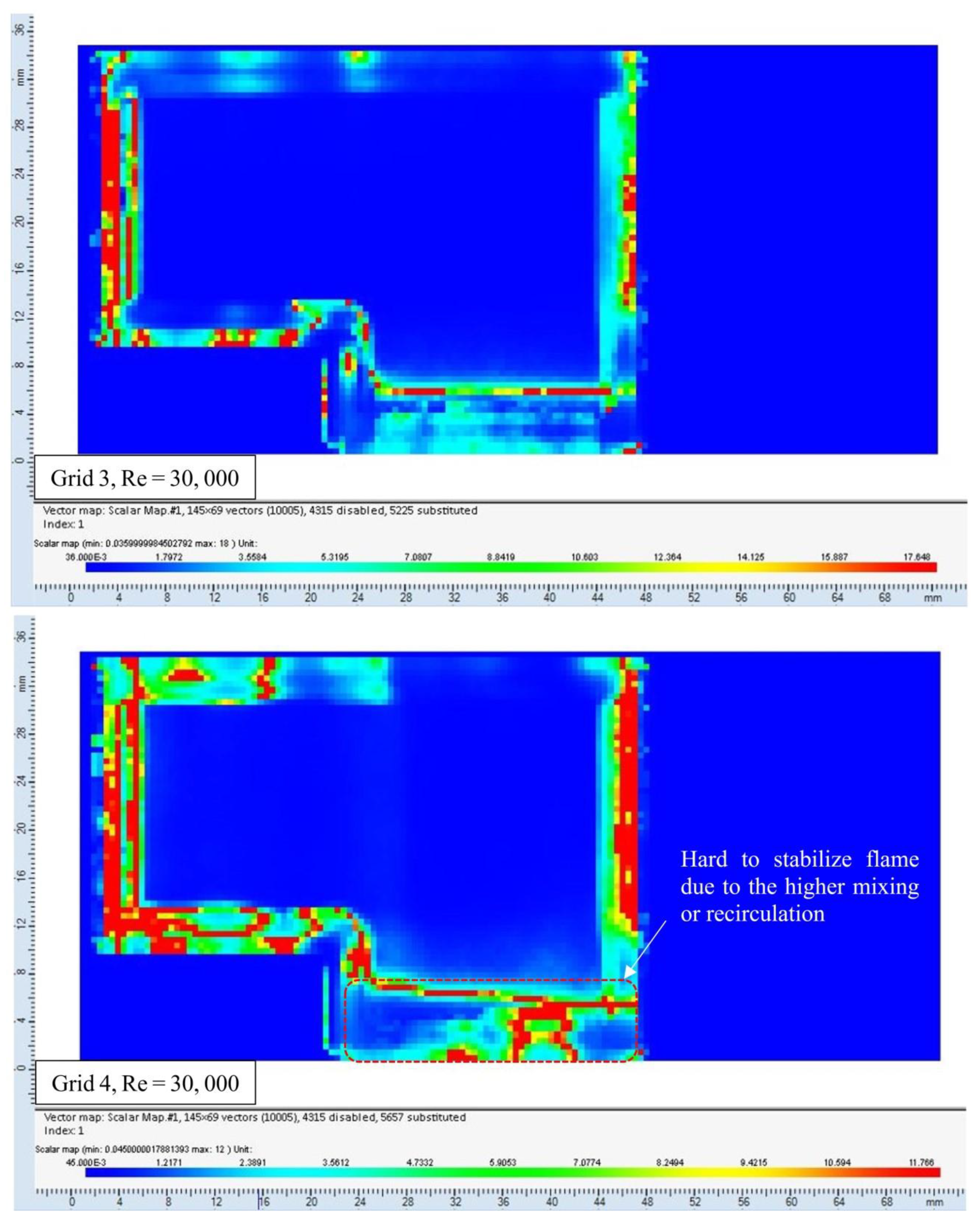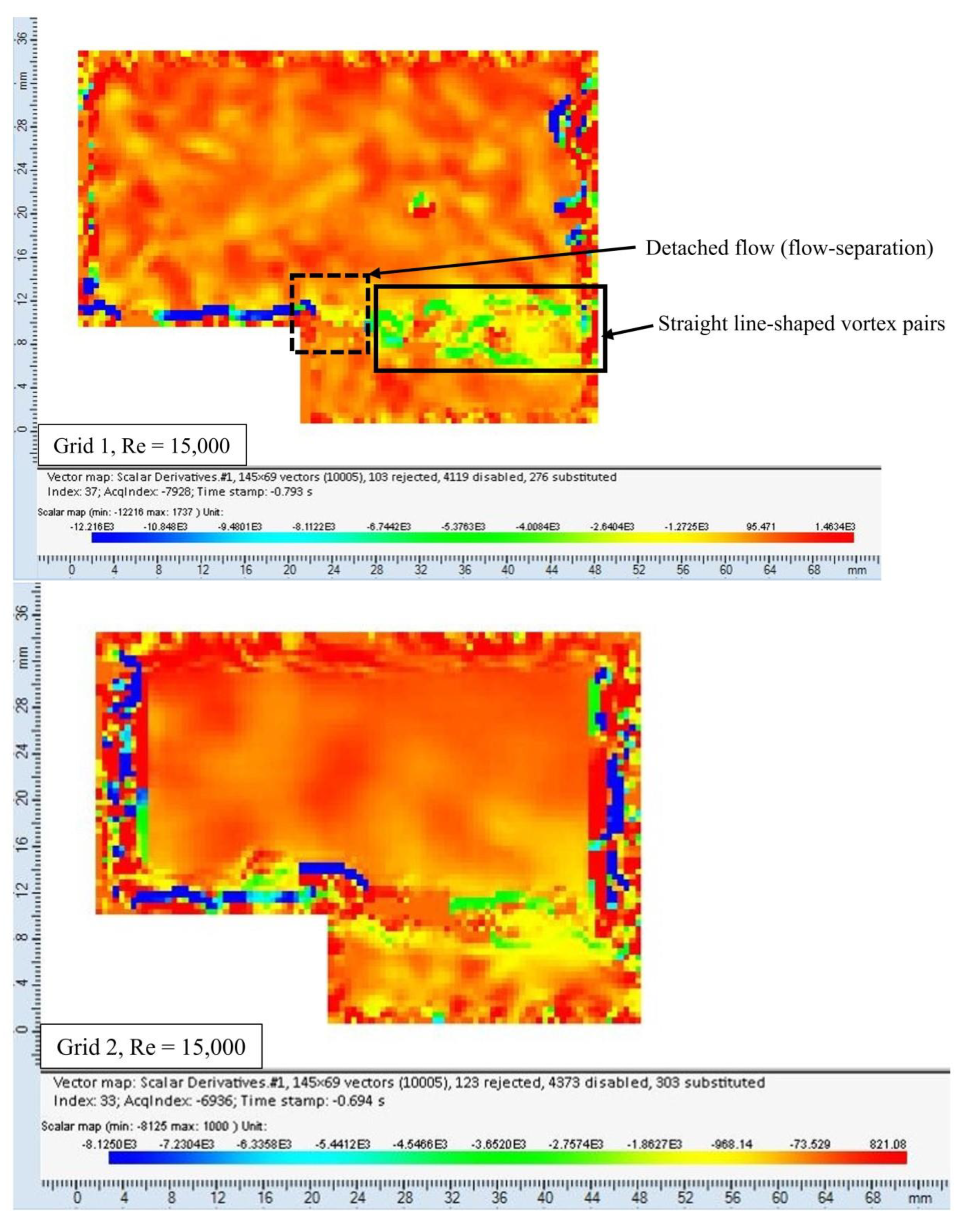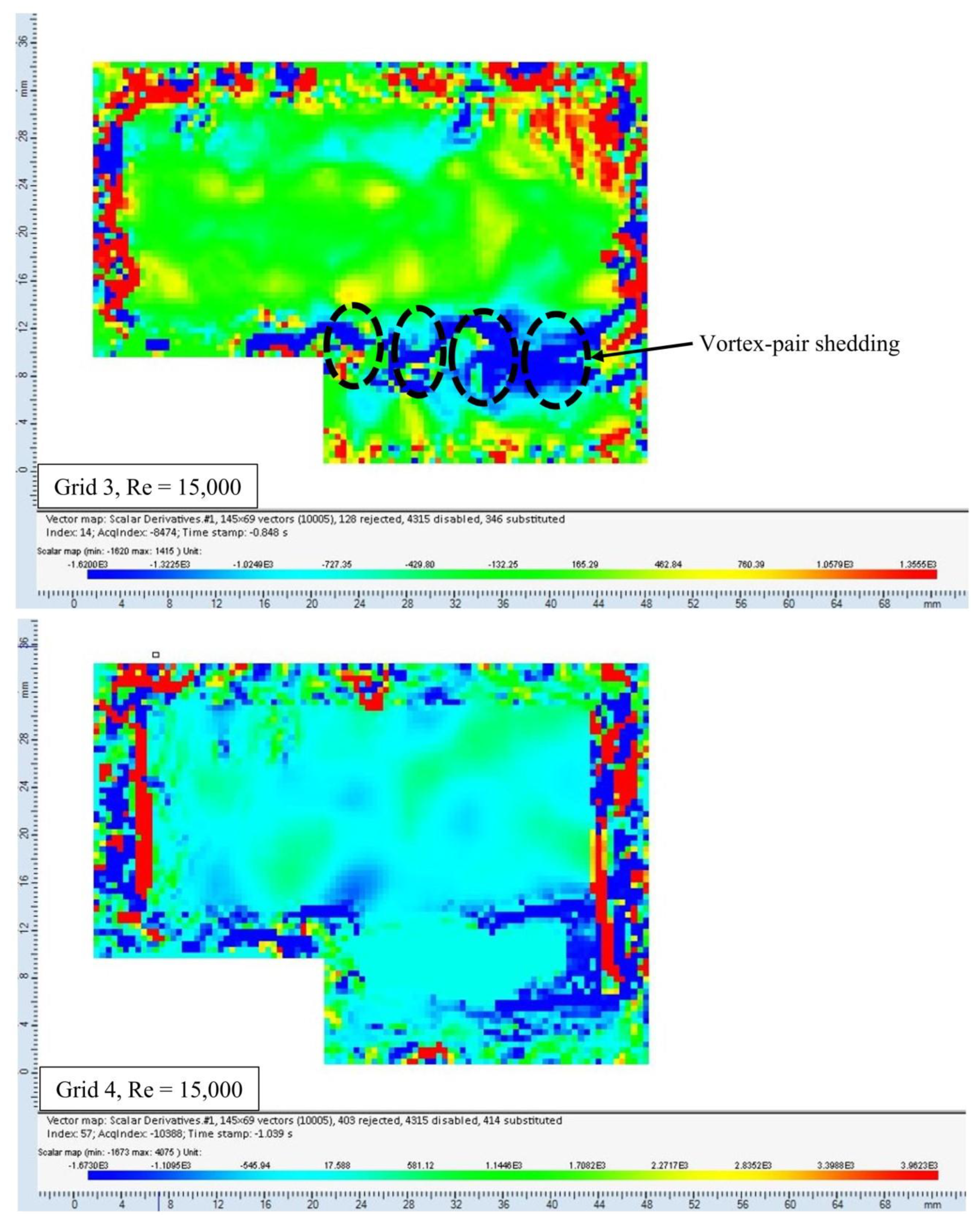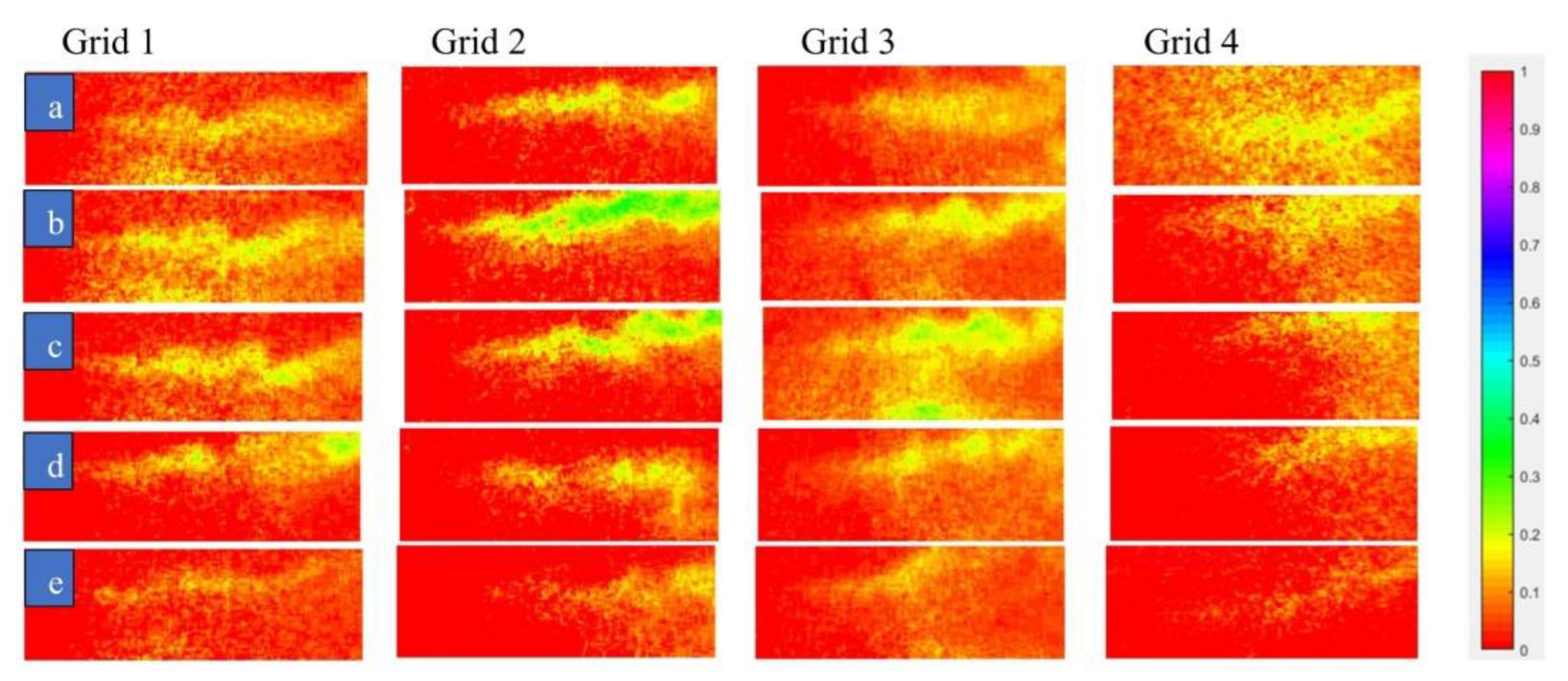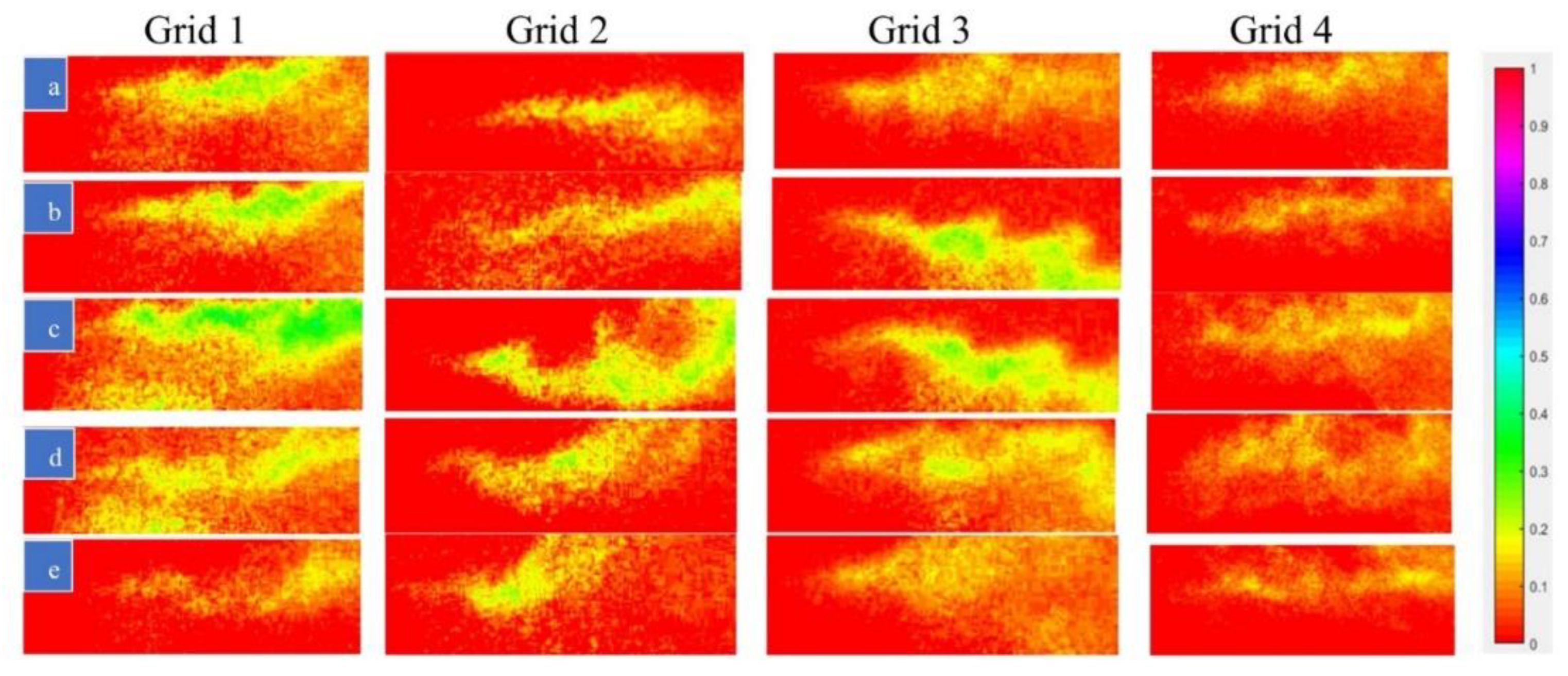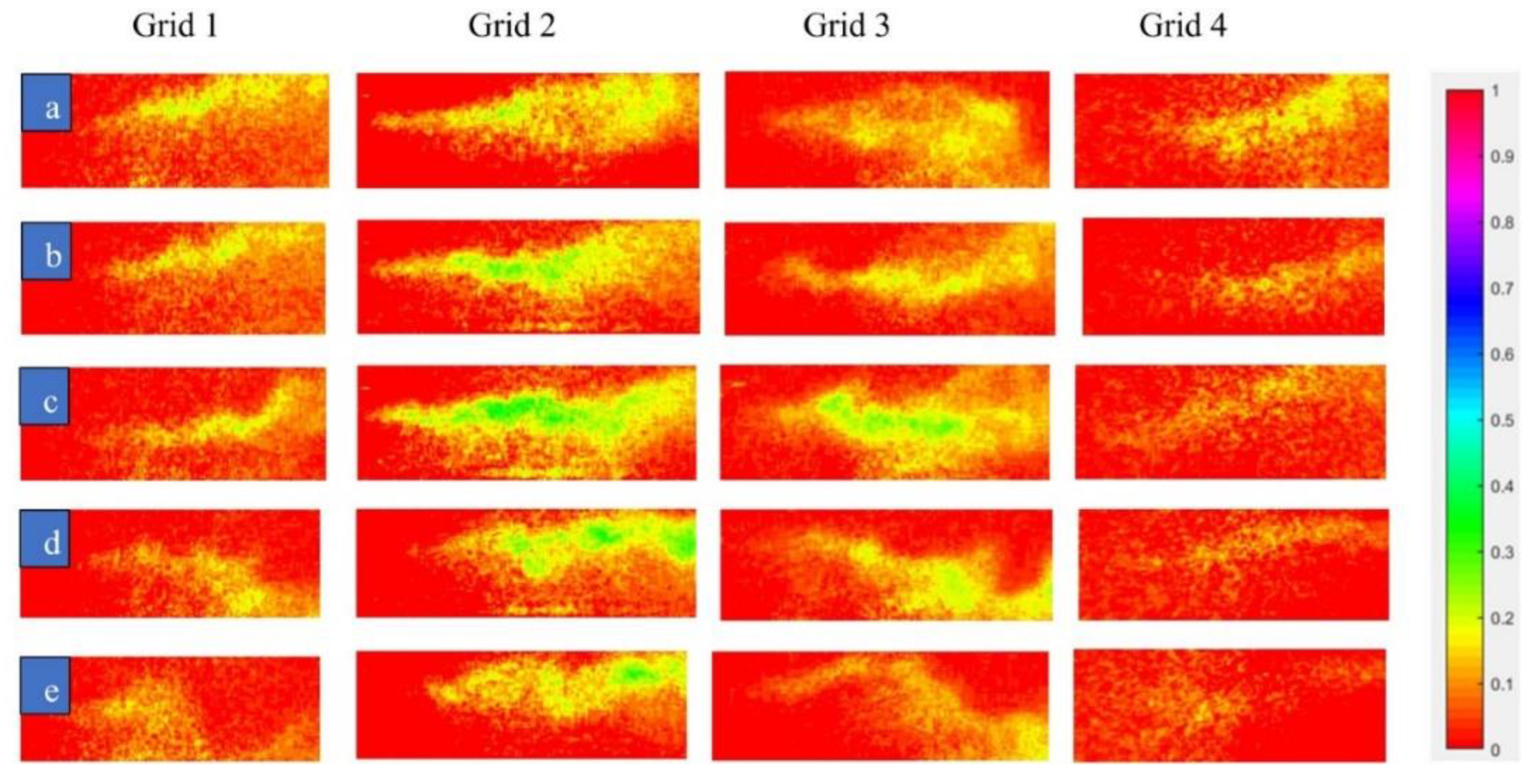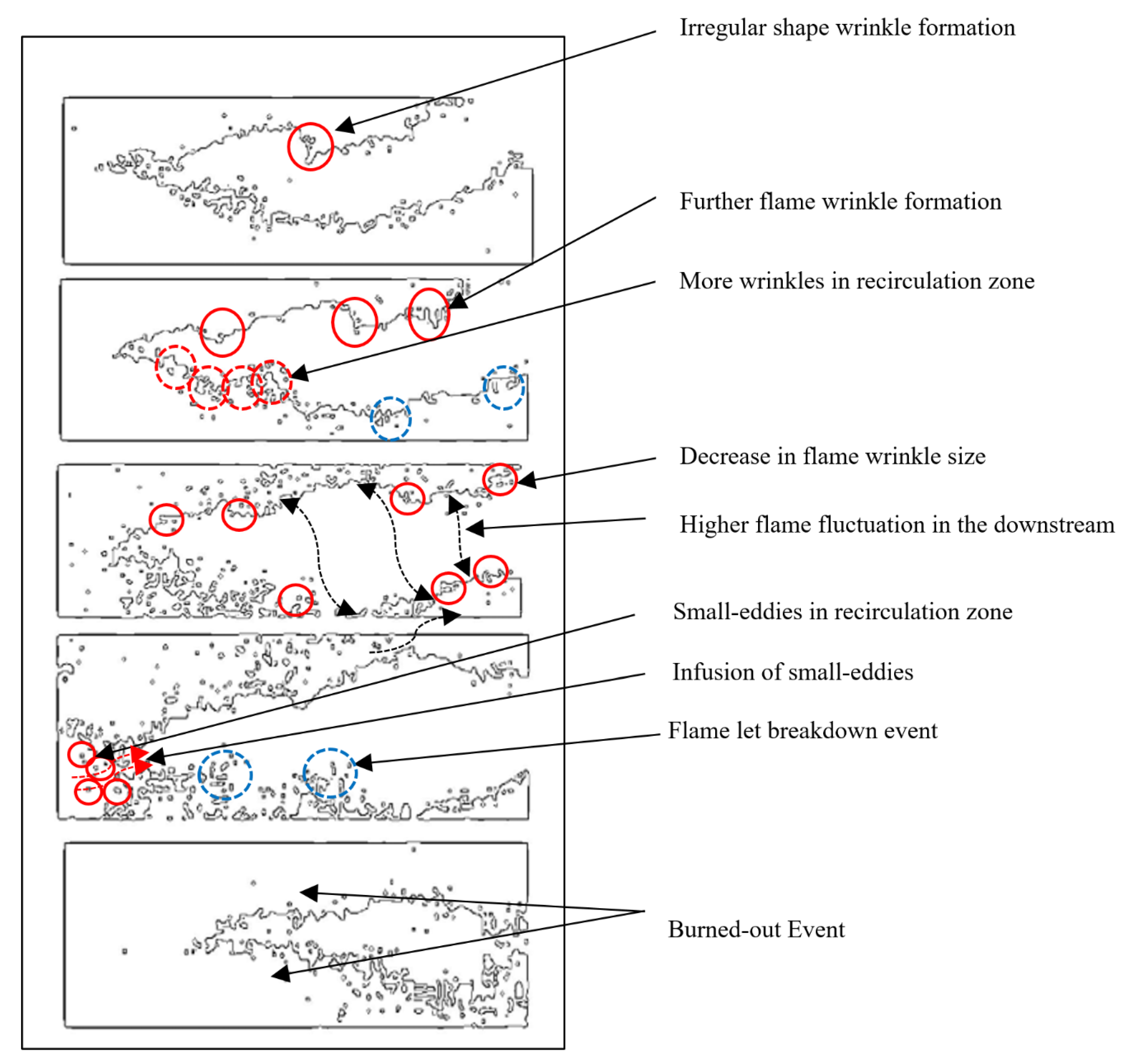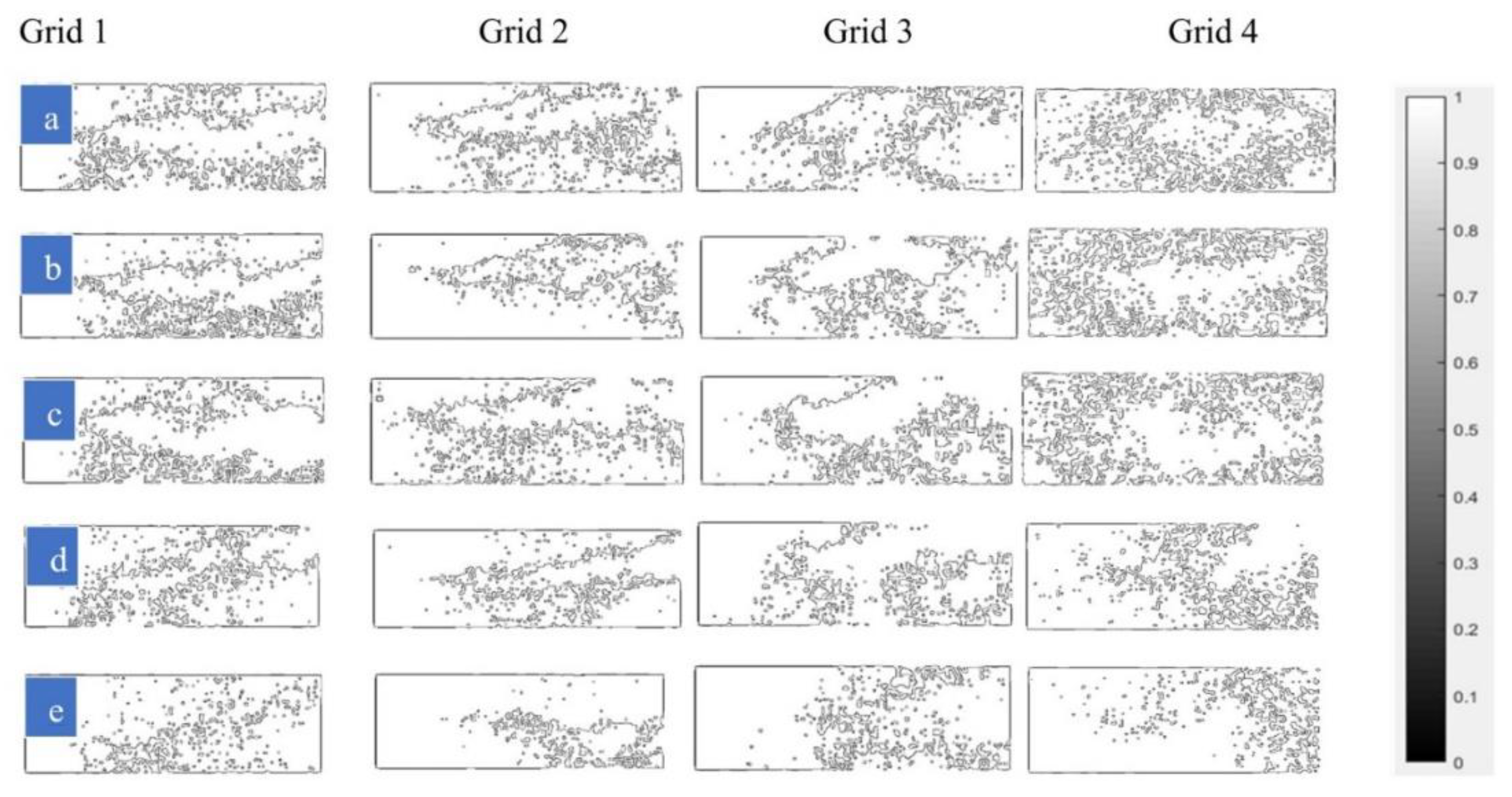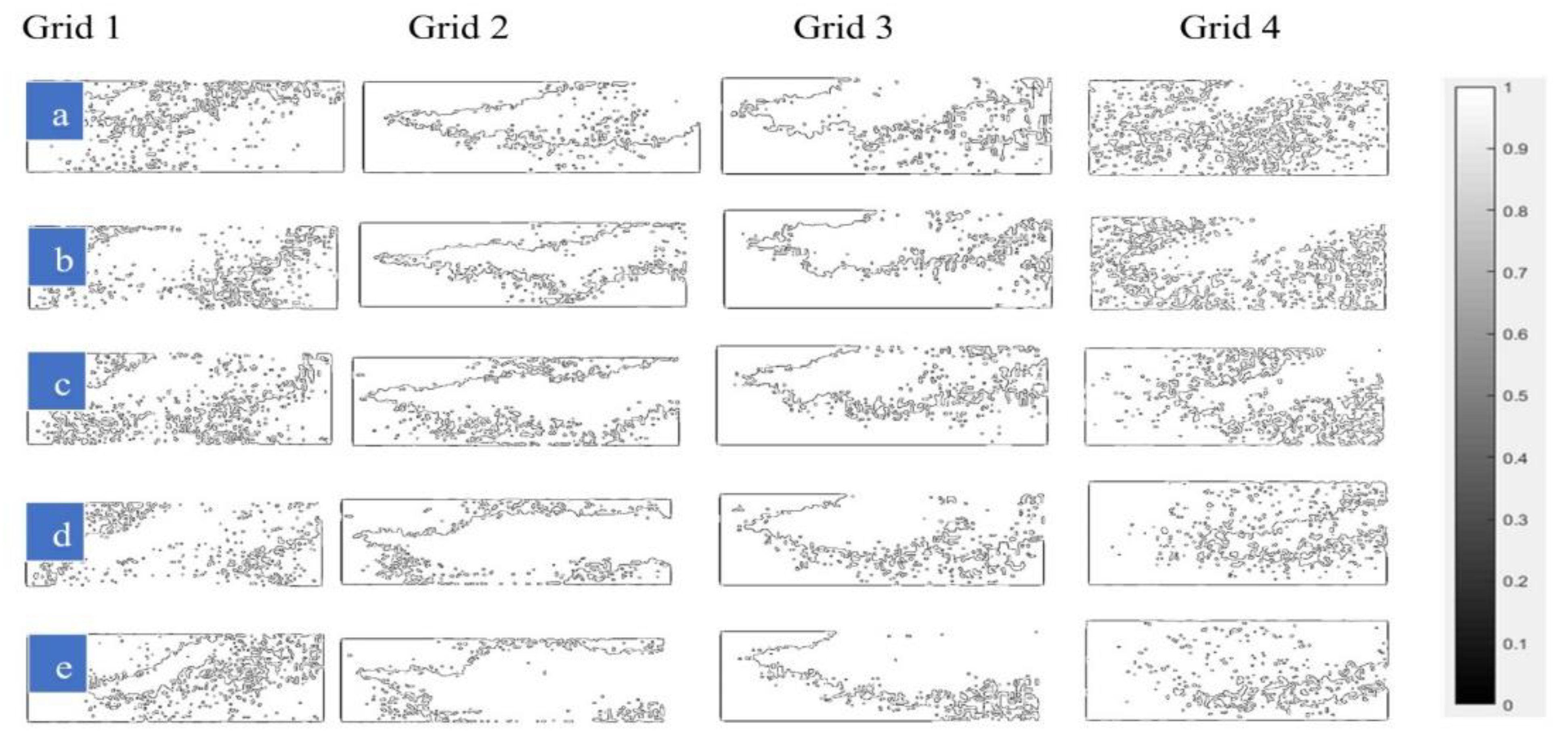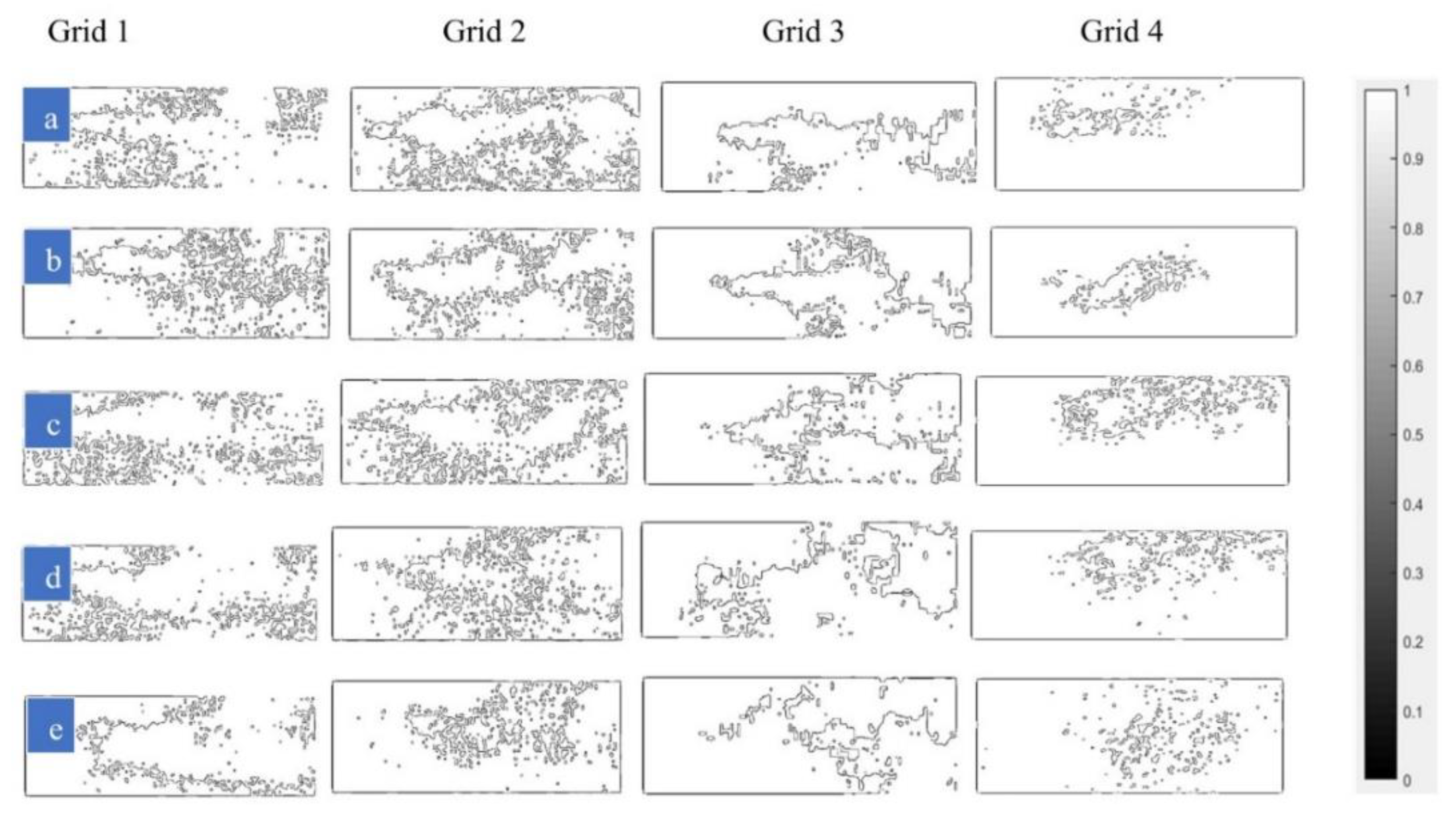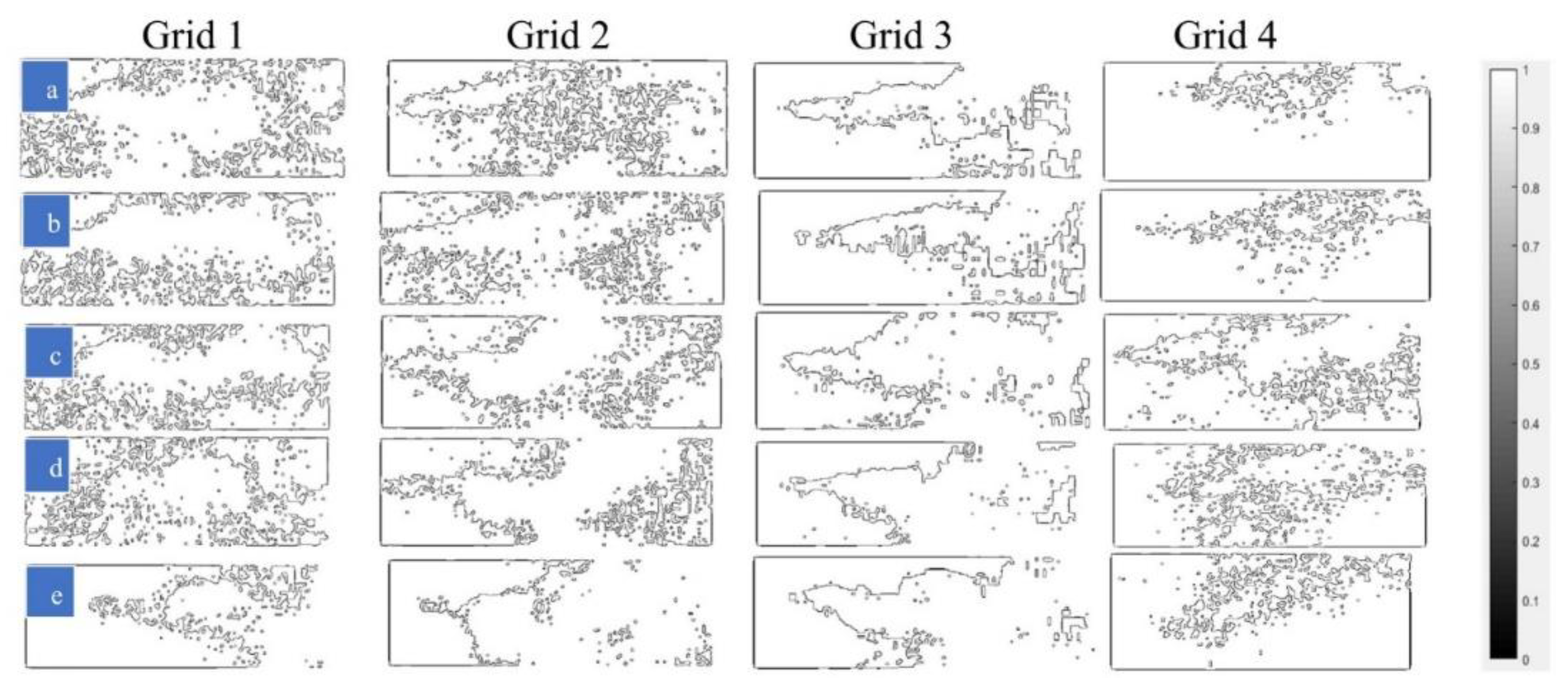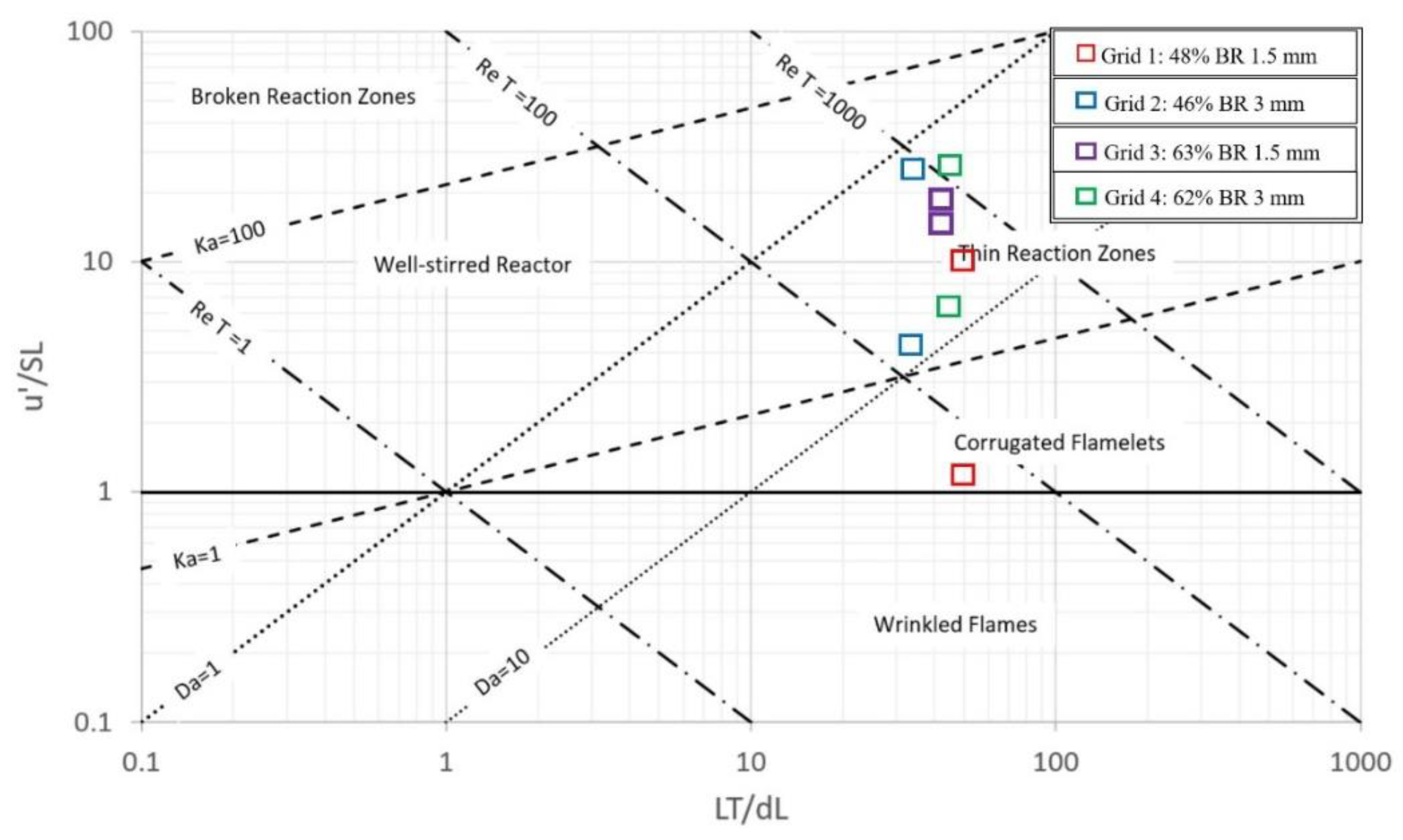3.1. Flow Field Characteristics Analysis
In this part, the authors aim to present the observed flow field characteristics obtained through experiments conducted with four grids at
Re = 15,000 and 30,000. The velocity vector field was plotted to observe the flow events due to the backward-facing step.
Figure 5 shows a dark background that was used to create a more impactful flow area and improve image contrast, resulting in clearer visualization of the flow. The grid at the combustor inlet induces homogenous turbulence in the flow because of interactions between wakes and jets behind the grid. This usually needs a significant distance downstream for the flow to become well-mixed and uniform. The authors optimized the combustor design by testing for the distance downstream that produced the best mixture. A detailed understanding of these inquiries can be found in [
2,
28,
32]. The flow accelerated once it passed the backward-facing step, as seen in
Figure 5. This happens because of the thermal dilation effects that the flow encountered downstream. The velocity contours showed the presence of a mixing or shear layer between the recirculation zone and the main flow. This layer was composed of vortices that were shed downstream from the edge of the backward-facing step. This low-speed recirculation zone helped to anchor the flame. Grids 3 and 4 had higher blockage ratios (BR), as expected flows showed fewer interacting vortices in the wake and jets of the grids, especially in the recirculation zone. At
Re = 15,000 and 30,000, the occurrence of vortex shedding downstream of the sharp corner of the step was observed consistently, regardless of the presence of grids or perforated plates. The flow experienced more fluctuations at
Re = 30,000 compared to
Re = 15,000 due to the higher turbulence present at
Re = 30,000.
In this article, the authors extracted the local velocities, vorticities, and other turbulent characteristics from the interrogation line and points distributed across the flow domain, as illustrated in
Figure 5. (For a detailed understanding of the PIV data extraction, acquisition, and post-processing methods, the readers are referred to [
32].) The velocities (U) and velocity fluctuations (
) were then calculated using Equations (3)–(5) and are presented in
Figure 6. The maximum velocities of 15 m/s and 25 m/s are measured at
Re = 15,000 and
Re = 30,000, respectively. This indicates an increase of 5 m/s in flow velocity at both
Re conditions. The maximum velocity fluctuations of 0.5 m/s and 0.25 m/s were observed for the u and v components, respectively. As expected, the perforated plate installed at the inlet of the combustor helped increase the flow velocity and flow fluctuation.
Turbulent intensity contour maps are instrumental in improving comprehension of the structure of combusting flows by visually depicting the turbulent intensity distribution throughout the combustion system. These maps are used to identify and analyze significant flow structure features, including flame stabilization mechanisms, flame front propagation, and flame extinction. By investigating variations in turbulent intensity, one can gain a deeper understanding of the intricate interactions between turbulence and combustion, ultimately facilitating enhanced efficiency, reduced emissions, and safer operation through improved design and optimization of combustion systems. With that in mind, the authors generated the turbulent intensity contour map in
Figure 7. These maps show how the recirculation zone behaves at different
Re and unveil how turbulence is distributed in the fluid domain.
Figure 7 also helps to locate the areas of lower turbulence (reduced mixing or recirculation) and higher turbulence (higher mixing or recirculation).
Figure 7 shows that when the blockage ratio is increased, the turbulent intensity increases too. Such outcomes indicate the increased amount of induced eddies in the recirculation zone at the foot of the step. In addition, when the hole diameter of the grid is increased, the turbulent intensity also changes; in both cases, increasing the hole diameter decreases the intensity. This is important because the pilot flame used to ignite the premixed methane–air mixture is located near the foot of the backward-facing step.
Figure 7 shows that turbulence can influence flame anchoring or stability. It has been observed that the increase in turbulence has both pros and cons in the flame anchoring regime. While at a lower
Re of 15,000, the higher turbulence has shown an improvement in flame anchoring, which is due to the better mixing of the pilot flame charge. However, when the
Re is increased, a lower BR tends to help anchor the flame better compared to a higher BR. This is due to the infusion of too many eddies, which partly break up the pilot flame and causes instability. Consequently, it ultimately leads to flame blowout due to pilot flame extinction.
Grids 1 and 2 experienced less flow restriction (low BR) and thus have diffused turbulence at the recirculation zones. This aids in stabilizing the flame in the recirculation zone. On the other hand, Grids 3 and 4 exhibit concentrated turbulence. The higher flow restriction governs this behavior (high BR). Consequently, flame stabilization under Grids 3 and 4 would be challenging. The turbulence level (
) is high at the edge of the backward-facing step (refer to Equation (6),
Table 4) and in the recirculation zone.
Figure 7 also indicates how the flow fluctuation varies within the flow domain. The vortices in the shear layer (mixing layer) control the flow fluctuation at the lower part of the fluid domain. However, the overall flow fluctuation is controlled by grids and the Reynolds number. Grids 3 and 4 show more turbulent intensities compared to Grids 1 and 2 in the recirculation zone. This is again due to the higher blockage ratio of Grids 3 and 4.
The vorticities at the edge of the step are calculated using Equations (7) and (8).
Figure 8 presents the vorticity profiles. The vorticity profiles show the areas of lower and higher vorticity fluctuations. The vorticity fluctuation is very high between the 10 mm to 20 mm (the first peak) and 30 mm to 40 mm (the second peak) line distance from the reference/datum point. This is due to the significant change in velocity gradient and angular momentum in those areas, which reveals that the areas close to the step and upper part of the flow domain are susceptible to higher vorticity fluctuation. The turbulence level was found to be higher at the shear layer and is expected to have a higher vorticity value. In addition, maximum vorticity of 4100 rad/s and 50,000 rad/s was observed at
Re = 15,000 and
Re = 30,000, respectively. As expected, the vorticity level was high under Grids 2 and 4 (large HD), whereas it was low under Grids 1 and 3 (low HD). The PIV-derived vorticity contour maps are shown in
Figure 9. These maps show how the flow was detached from the backward-facing step. Once the flow was detached, it formed low-speed recirculation zones downstream. The vorticity contours were successful in resolving the vortex pairs. The high vorticity level at the shear layers indicates that the system is designed and tested with high standards. As expected, the vorticity maps also show that the vorticity in the recirculation zone is higher under Grids 2 and 4. This is again due to the velocity gradients that are steep along the flow path under Grids 2 and 4. The y-velocity component dominated the axial component, which increased the rotation of the velocity vector. The opposite was true under Grids 1 and 3. In the colormap scales, the positive and negative values of vorticity are seen indicating the presence of both counterclockwise and clockwise vortices in the flow. Furthermore, the vorticity scale was six times higher at
Re = 30,000 compared to
Re = 15,000. The vortex pairs look like a straight line at
Re = 30,000, whereas it looks like a spotted dot at
Re =15,000. In general, the authors found that the vorticity orientation and magnitude in the contour maps were mostly controlled by velocity gradients and rotation or angular momentum within the fluid elements. The vorticities were induced through the interaction of different flow components such as shear layers, boundary layers, or swirling flows, which created regions with intense vorticity where fluid elements rotate or circulate. The presence, strength, and spatial distribution of vortices in the vorticity maps helps understand the flow dynamics under turbulent environments and guide optimization of the design of the combustor.
The PIV results showed how the flow concentration was uniformly distributed inside the combustion chamber. The flow homogeneity was achieved using the different grids at the combustor inlet. The sharp velocity gradients were seen at the backward-facing step, which aids in accelerating flame growth. The bottom wall close to the step was densely populated by small eddies. These eddies controlled the flame anchoring mechanism inside the combustor. The PIV gave a detailed statistical explanation of the flow behavior, which
Table 6 lists below. However, to understand the relation of flow behavior with flame dynamics, a PLIF study was carried out.
3.2. Flame Characteristics Analysis
A flame study was conducted at
Re = 15,000 (10 m/s) and
Re = 30,000 (20 m/s) using the 10-kHz rate PLIF. The base image (without the flame) and the raw image (with the flame) were post-processed using the MATLAB image processing tools described previously in
Figure 4.
Figure 10i–iv below shows how a typical flame profile and flame edge were generated using those image processing tools.
The base image without the flame is shown in
Figure 10i. This is when the igniter was off and there was no active combustion in the system.
Figure 10ii is the raw image with flame when combustion occurred in the system.
Figure 10iii shows the flame profiles that were generated using the MatLab-based image processing procedures listed in
Figure 4. Flame profiles locate the reaction zones, show the thickness of the flame core, help to understand the flame expansion and stretching, etc.
Figure 10iv shows the flame edges. The flame edges revealed the location, shape and size of flame wrinkling, and the presence of vortices, and showed how vortices infused the flame core and made the flame thin and stretch.
The flame progression is shown in
Figure 10v. Images (a) to (e) show the progression of the flame growth from ignition initiation through blowout. Image (a) indicates the initial combustion stage; (b) shows the initiation of wrinkles; (c) reveals the formation of more wrinkles; (d) shows the breakdown of the flamelets; and (e) shows the burnout of the flamelets.
The presence of an unburned air–fuel mixture inside the burned gases and vice versa are observed in
Figure 10(va). Eventually, combustion completely burns all the air–fuel mixture. The authors studied the recess length and made sure that the mixing, residence time and air–fuel ratio were adequate for the complete combustion of methane air. There were different levels of turbulence in the flame. Additionally, the flame profiles show irregularly shaped wrinkles (handgrip-like structures), see
Figure 10(vb). The wrinkles continued to form as the flame progressed downstream as shown in
Figure 10(vc). The flow fluctuation, thermal instabilities caused by buoyancy and expansion, and local flame viscosity controlled the flame wrinkling. The turbulent and velocity scales—for example, velocity fluctuation (u’) and turbulent length-scale (L
T)—generated high compressive forces in the flame, leading to accelerated flame–flame interactions. This interaction enhanced the reactant-product pocket formation rate [
36], causing many finger-shaped wrinkles to form in the flame. It also causes to change in flame thickness, (δ
L) and flame expansion.
After the flame wrinkling, the next event is called the breakdown of the flamelet or pinch-off event
Figure 10(vd). The large-scale fluid structures caused the reaction zone to shatter, leading to flamelet detachment from the edges. Local velocity fluctuations and thermal diffusion further accelerated pinch-off events. Near the bottom wall, at a distance downstream, the breakdown (pinch-off) event accelerated. This was due to the infusion of small eddies into the flamelet regime. These small-scale, semi-detached, burned gases sometimes reach self-ignition temperature and start to burn out or disappear. This is commonly known as a burned-out event
Figure 10(ve). The pinch-off and burnout events occurred spontaneously and were controlled by parameters such as pressure, turbulent length scale, and velocity fluctuation. Flame profiles observed in this research work are very thin (thin reaction zone); therefore, all the images presented below are intensified and zoomed in for better interpretation and visualization.
The authors conducted a qualitative analysis of flame behavior in this article. Therefore, the authors combined all the images together and present them here so that an overall understanding of how flame propagates and interacts under different grids and Reynolds numbers could be made. First, thin fluctuating flame profiles are seen in
Figure 11,
Figure 12 and
Figure 13. Additionally, the flame width increased as it moved downstream. This is referred to as flame broadening. The local flame diffusivity increased due to the enhanced heat and mass transfer imparted to the reaction zone by the turbulent eddies. This caused the flame’s core structure (width) to increase. As reported in [
37,
38], these large-scale eddies and wrinkles should enhance the reactant burning rate, flame burning area, and flame propagation speed. As the velocity increased downstream, high-energy fluid structures formed. This increased the turbulent eddy diffusivity and suppressed the strain rate effect, influencing flame stretching. Broadened flame structures were observed under all grids.
The effect of grids on flame characteristics has been studied (see
Figure 11,
Figure 12 and
Figure 13). The flame profiles under Grids 1 and 3 had more wrinkle growths. This was due to the higher change in thermal diffusion and viscosity of the flame under those grids, as also reported in [
5]. However, there is less presence of large-scale wrinkles in the flames under those grids. Thus, flame stretching and flame width are less under Grids 1 and 3. The opposite is true for the flame under Grids 2 and 4 (see
Figure 11,
Figure 12 and
Figure 13).
The effect of two different Reynold’s numbers on flame evolution has been studied. The flame expansion was faster at
Re = 30,000 (20 m/s) (
Figure 14,
Figure 15 and
Figure 16) compared to
Re = 15,000 (10 m/s) (
Figure 11,
Figure 12 and
Figure 13). The local flame strain rate increased with the increase in flow velocity. This strain tries to suppress flame growth. However, higher-order turbulence at higher
Re aided in overcoming this challenge. Similar research on flame expansion rate is reported in [
39]. Additionally, at
Re = 30,000, the flow mixture velocity (20 m/s) dominated over turbulent eddy viscosity (
, see
Table 6. Therefore, the flame front broadened in both axial and radial directions and allowed the small eddies to infuse into the flame core (see
Figure 14,
Figure 15 and
Figure 16).
The flame wrinkling (irregularly shaped edges) was higher at
Re = 30,000 compared to
Re = 15,000. This was because a large number of small-scale eddies and higher flame instabilities (mostly the flame fluctuation) were present at
Re = 30,000 (see
Figure 14,
Figure 15 and
Figure 16).
The effect of the equivalence ratio (Φ) on flame propagation was also investigated. The reactant-product pocket formation rate increased with fuel loading as Φ increased. Therefore, at
Re = 30,000 and Φ > 1, the flame wrinkling rate is maximum. Additionally, the pinch-off and burnout rates were higher at
Re = 30,000 (
Figure 14,
Figure 15 and
Figure 16d,e). The same finding is also reported in [
40]. In addition, the flame stretching rate was found to be higher at
Re = 30,000. This was due to the large-scale wrinkles that interacted with each other and formed new wrinkles along the flame edges. As a result, the flame stretched across those wrinkles. The opposite is true for
Re = 15,000.
The flame profiles alone do not offer a comprehensive understanding of flame behavior. To gain more detailed insights into crucial flame characteristics such as flame boundaries and wrinkles, the authors utilized MATLAB image processing tools with in-house coding (see
Figure 4) and generated corresponding flame edges (See
Figure 17).
Figure 17 shows how the wrinkle initiated and grew with time. It also shows how the wrinkles changed their shape and size from ignition through the blowout. The wrinkles have an irregular shape with handgrip-like structures. Wrinkle shape does not change, but wrinkle size changes throughout the flame evolution (ignition to burnout). The flame edges show the presence of many small eddies in the recirculation zone. The same behavior is noticed in the PIV analysis. This validates the role of the backward-facing step in flame anchoring.
The flame had more fluctuation downstream (see flame edges under
Figure 18,
Figure 19,
Figure 20,
Figure 21,
Figure 22 and
Figure 23). Flame growth was mostly controlled by flame wrinkling and turbulence. The flame was continuous and had no flame extinction for the
Re conditions considered in this paper. Wrinkle formation (
Figure 18,
Figure 19,
Figure 20,
Figure 21,
Figure 22 and
Figure 23b) was adequate to maintain a continuous flame and not too extreme. The flame edges also showed how the small eddies infused into the flame core and the flamelet (small-scale flame eddies) detached and reattached to the flame core. These events were more common at
Re = 30,000 (see
Figure 21,
Figure 22 and
Figure 23b–d) due to the increase in flame displacement rate. In other words, vorticity-strain rate effects were higher at
Re = 30,000.
The flame was thinner at
Re = 30,000 and wider at
Re = 15,000 (see
Figure 18,
Figure 19,
Figure 20,
Figure 21,
Figure 22 and
Figure 23). This could be justified by the PIV-derived data presented before. The velocity contours (previously presented in
Figure 5) show that the local flow velocity was high and residence time was low across the shear layer at
Re = 30,000. Consequently, the flame did not have enough time to expand laterally and became thinner. The opposite is true at
Re = 15,000. The flame edges also show that the flame wrinkling rate is higher under Grids 1 and 3, whereas pinch-off and burnout rates are higher under Grids 2 and 4. The same behavior is noticed in the flame profiles reported earlier in
Figure 11,
Figure 12,
Figure 13,
Figure 14,
Figure 15 and
Figure 16. A similar observation is reported in [
41,
42].
The flame profiles (
Figure 11,
Figure 12,
Figure 13,
Figure 14,
Figure 15 and
Figure 16) and flame edges (
Figure 18,
Figure 19,
Figure 20,
Figure 21,
Figure 22 and
Figure 23) presented above show that the CH layer (reaction zone layer) is thinner at both
Re conditions. However, the CH layer thickness increased slightly downstream. This happens because the turbulence dominated over the strain rate downstream. The CH layer resembled both flamelet-like and diffuse-like structures. The authors believe that the flame signal detected by the C-X CH PLIF was not entirely the CH signal: there might be a presence of some CH * chemiluminescence. This is why in some cases the flame profiles looked diffuse. The authors completed some preliminary iterations on methane–air premixed reacting flames using the CH PLIF. The authors believe that there are still many questions and issues that need to be addressed in future research iterations. For example, the CH filter and the operating parameters of the camera intensifier units such as gate pulse width and gate exposure/opening time need to be re-tuned according to the higher test operating conditions. Additionally, the wavelength tuning for the C-X band of CH PLIF should be further examined. The flame edges showed that the CH signal decreased with the increase in
Re. The authors will also consider this in the next research iteration. The authors are recommending preheating the reactants at elevated temperatures for higher
Re combustion tests. The incorporation of higher-order alkaline into the reactants might resolve this issue. However, a series of experimental tests and more theoretical research must be conducted before making any conclusion on this issue.
The effect of equivalence ratios (Φ) on flame evolution was investigated using the flame profiles and edges reported above. Data from the temperature sensors (k-type) indicate that the chamber heat release rate increased with the increase in fuel loading, Φ. This is because the combustion radical fraction and their reaction rates increase with Φ. The same behavior is reported in [
1,
5,
43]. The authors used a series of temperature sensors (non-intrusive) on the combustor walls. The temperature sensors sensed the wall face temperature during the combustion. After that, the LabView tool generated the associated heat release rate from the combustor walls, exhaust chamber, and cooling chamber. This information has already been published by two of the co-authors of this paper, [
28,
32].
The flame reaches the maximum static temperature (~2200 K) at Φ =1.2. Therefore, according to the literature [
6], the flame surface consumption rate, flame surface area, and flame length should increase at Φ > 1. Additionally, the flame surface area directly relates to the flame burning velocity and flame front curvature. Thus, at higher Φ, the flame burning area and flame front curvature should increase [
3,
31,
43]. The flame fluctuation (less radical kinetics) is less for the lean mixture (Φ = 0.8). A moderate level of flame fluctuation is seen at Φ = 1.2 (see
Figure 18,
Figure 19,
Figure 20,
Figure 21,
Figure 22 and
Figure 23). However, this small fluctuation does not affect the flame stability studied in this paper, as also reported in [
4]. The authors believe that more tests at variable Φ need to be conducted to conclude these predictions.




